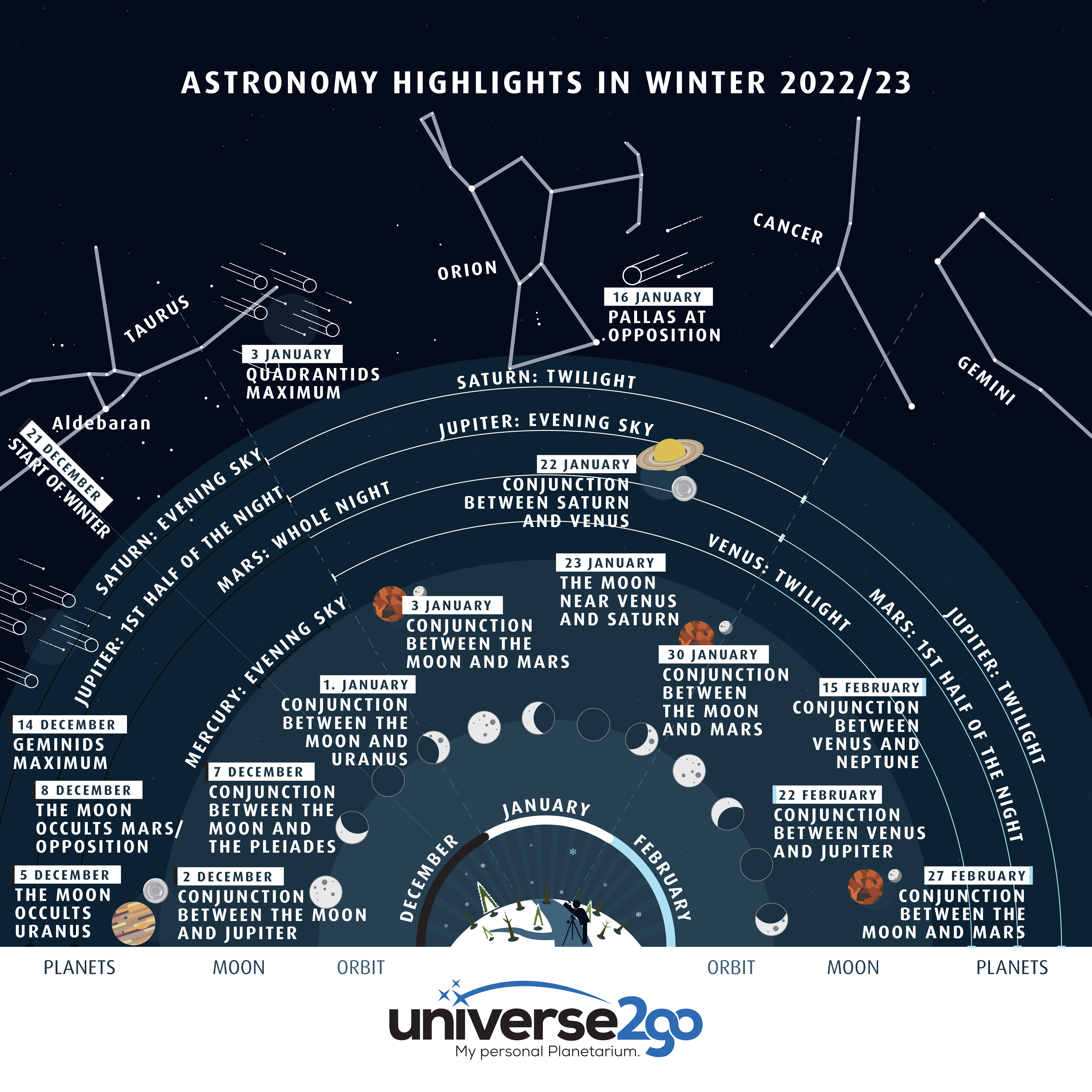Mars at opposition, two planetary occultations by the Moon, the Geminids and beautiful triangular arrangements between the Moon and the planets. This winter, there are many reasons to look towards the stars. And you should join in!
In the “Astronomy Highlights in Winter 2022/23” infographic, you can find important celestial events for the next three months. Have fun observing!

December
02/12 Conjunction between the Moon and Jupiter
When darkness is upon us, we can gaze at the Moon and Jupiter on the south-eastern horizon. The gas giant will be blazing with an intensity of -2.5 magnitudes.
05/12 The Moon occults Uranus
The Moon and the planets travel along an imaginary line known as the ecliptic. This is the plane along which the planets and the Sun appear to move. Every now and then, the Moon occults one of the planets. And that time has come once again, as the dark side of the Moon approaches and occults Uranus at 5:34pm.
07/12 Conjunction between the Moon and Plejades
In the early hours of 7 December, the almost-full moon reaches the Golden Gate of the Ecliptic, which is flanked by the famous Hyades and Pleiades star clusters.
08/12 The Moon occults Mars/Opposition
Mars is at opposition to the Sun today and is shining particularly bright and looks magnificent through a telescope. During this year’s opposition, the planet reaches a diameter of 17 arc seconds and a height of 66 degrees above the horizon from central Europe. And today is also a double event as, in the early hours of 8 December, at around 6am, our Moon occults the Red Planet.
14/12 Geminids
If the skies are clear in the evening, look towards the south. You will see the Geminids meteors emerging from the constellation of Gemini. Or more precisely, from a spot two degrees above the star, Pollux. With 120 meteors per hour, this shower is one of the events with the highest fall rates. In the early evening, up to 10pm, you can view it undisturbed by the Moon, as this is when our satellite appears over the horizon.
Lunar phases:
08/12 Full moon, 16/12 Waning quarter, 23/12 New moon, 30/12 Waxing quarter
January
01/01 Conjunction between the Moon and Uranus
Over and over, encounters or occultation between the Moon and planets take place along the path of the ecliptic. At the start of the new year, the Moon scrapes past Uranus at a distance of only half a degree.
03/01 Conjunction between Moon and Mars
Two bodies are competing for brightness today… the Moon and Mars. Both appear in the eastern skies when darkness falls. The Moon passes eastward beneath Mars.
03/01 Quadrantids
The next meteors are on their way to us – the Quadrantids. This meteor shower originates in the constellation of Bootes. The meteors shoot across the sky at a maximum rate of 120 per hour. The Moon only leaves our field of vision in the early hours of the morning.
16/01 Pallas at opposition
With a diameter of 588 kilometres, the asteroid Pallas is the second largest in the asteroid belt between Mars and Jupiter. During its opposition, it is so bright that we can easily see it with a small telescope and, theoretically, even with binoculars. To tell it apart from the stars, you should use a star chart whilst observing.
22/01 Conjunction between Saturn and Venus
A good view of the horizon is essential for this event. During twilight, the stunningly bright Venus outshines the considerably weaker, but still bright, Saturn above the western horizon. From 5:30pm, we have an hour-long opportunity to follow this celestial pair, both of which become weaker and then disappear into the haze.
23/01 The Moon near Venus and Saturn
An attractive event for all who are interested… Today a slim crescent moon joins the planets Venus and Saturn. Together, they are a dream team for a wonderful twilight photo.
30/01 Conjunction between the Moon and Mars
This evening, the Moon visits the Red Planet. During the night, our satellite draws nearer until both objects are around one degree apart in the morning hours.
Lunar phases:
07/01 Full moon, 15/01 Waning quarter, 21/01 New moon, 28/01 Waxing quarter
February
15/02 Conjunction between Venus and Neptune
Venus and Neptune come to within 0.25 degrees of each other – a very close encounter between two very different planets. Whilst Venus beams like a floodlight, Neptune shines 50,000 times less bright.
22/02 Conjunction between Venus and Jupiter
This evening, the crescent moon appears with two planets. A beautiful view which you should not miss.
27/02 Conjunction between the Moon and Mars
This evening, Mars and the Moon can both be found in the constellation Taurus.
Lunar phases:
05/02 Full moon, 13/02 Waning quarter, 20/02 New moon, 27/02 Waxing quarter
